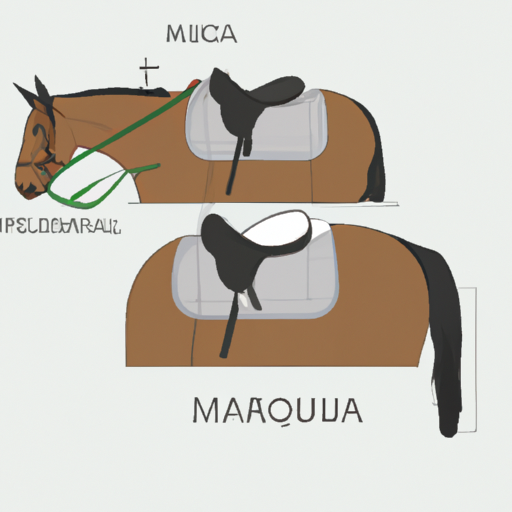– Saddle Safety: Ensuring a Safe and Enjoyable Ride
Saddle safety is of utmost importance for anyone who enjoys horseback riding. It not only ensures a secure and comfortable ride but also prevents any potential injuries to both the rider and the horse. Whether you are a beginner or an experienced rider, following some tips on saddle safety can greatly enhance your riding experience.
First and foremost, it is essential to choose the right saddle for yourself and your horse. A well-fitted saddle will distribute the rider’s weight evenly and provide adequate support. The saddle should rest comfortably on the horse’s back, without any pressure points or areas of rubbing. It is recommended to seek professional assistance in saddle fitting to ensure a perfect match.
Secondly, understanding proper saddle positioning is crucial. The saddle should be placed on the horse’s back, just behind the shoulder blades, avoiding any interference with the movement of the front legs. Improper positioning can cause discomfort to the horse and affect its balance, leading to potential accidents.
Furthermore, maintaining the condition of your saddle is essential for both safety and comfort. Regular cleaning and conditioning will prevent the leather from drying out, cracking, or becoming slippery. It is also important to check the integrity of the saddle, ensuring that the stitching, billets, and girth straps are in good condition before each ride.
Another aspect to consider is the proper use of saddle pads or blankets. These provide additional cushioning and shock absorption, protecting both the horse’s back and the rider. The pad should be compatible with the saddle and fit well without adding excessive bulk that could affect saddle stability.
Additionally, proper mounting and dismounting techniques are crucial for the rider’s safety and the well-being of the horse. Always ensure that the stirrups are adjusted to the appropriate length, allowing your feet to rest comfortably. When mounting, use a mounting block or ask for assistance to avoid unnecessary strain on the horse’s back and saddle.
Last but not least, regularly checking the fit and condition of the saddle is essential. As horses can change shape due to factors such as age, fitness, and diet, it is important to reassess the saddle fit periodically to ensure continued safety and comfort for both the rider and the horse.
By following these tips for saddle safety, you can enjoy a secure and comfortable ride while minimizing the risk of accidents or injuries. Remember, investing in saddle safety is investing in the overall enjoyment of horseback riding.
– Mastering Saddle Comfort: Key Tips for an Optimal Riding Experience
When it comes to mastering saddle comfort for an optimal riding experience, one crucial aspect that cannot be overlooked is saddle safety. After all, ensuring a secure and comfortable ride is of utmost importance for any cyclist. To help you achieve this, here are some key tips to keep in mind.
First and foremost, it is essential to choose the right saddle for your body and riding style. Saddle comfort can vary greatly depending on factors such as the width, shape, and padding of the saddle. It is worth investing time in finding a saddle that suits your specific needs and preferences. Consider factors such as your body anatomy, the type of bike you ride, and the kind of cycling you engage in.
Additionally, proper saddle height and positioning are crucial for a safe and comfortable ride. A saddle that is too high or too low can lead to discomfort, pain, and even injuries. To determine the correct saddle height, start by placing your heel on the pedal at its furthest point. Your leg should be almost fully extended, with a slight bend in the knee. Fine-tune the height according to your comfort and riding efficiency. Likewise, saddle positioning, including the tilt and fore/aft adjustment, should be adjusted to ensure optimal weight distribution and reduce pressure points.
Paying attention to your cycling attire can also contribute to saddle safety and comfort. Wearing padded shorts or using a gel saddle cover can provide extra cushioning and reduce pressure on sensitive areas. Furthermore, using chamois cream can help prevent chafing and improve overall comfort during long rides.
Regular maintenance and care of your saddle are essential for both safety and longevity. Keeping your saddle clean and properly lubricated will prevent it from wearing out quickly and ensure a smooth and comfortable ride. Inspect the saddle for any signs of damage, such as cracks or tears, and replace it if necessary.
Lastly, listen to your body. If you experience persistent discomfort, numbness, or pain while riding, it is essential to address the issue promptly. Consult a professional bike fitter or a healthcare provider specializing in sports medicine to assess your riding position and address any potential underlying issues.
In conclusion, prioritizing saddle safety is integral to achieving a secure and comfortable riding experience. By selecting the right saddle, adjusting it properly, using appropriate cycling attire, and maintaining it regularly, you can ensure a safe and enjoyable ride, free from discomfort and injuries.

